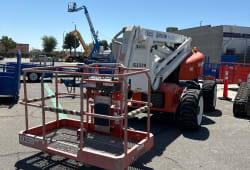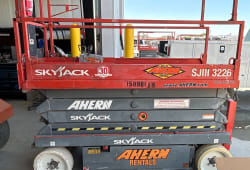Mud, Mountains, and Machines: Off-Highway Trucks Conquering Challenging Terrains
9 Min read
)
January 20, 2024
Off-highway trucks are the unsung heroes of heavy-duty industries, navigating through some of the most challenging terrains on Earth. This kind of trucking on challenging terrains is an exhilarating and demanding aspect of the transportation industry that involves the operation of heavy-duty trucks in rugged and unconventional environments. Unlike traditional highway driving, off-highway trucking requires specialized vehicles and skilled drivers to navigate through rough terrains, providing a unique and thrilling experience. This form of trucking plays a crucial role in various industries such as construction, mining, forestry, and agriculture, where access to remote or difficult-to-reach locations is essential. In this detailed blog, we'll explore the remarkable world of off-highway trucks as they conquer mud, mountains, and rough landscapes with cutting-edge technology and robust design.
Key Elements of Off-Highway Trucks
Specialized Vehicles: Off-highway trucks, often referred to as off-road or haul trucks, are purpose-built for challenging terrains. These vehicles are equipped with features like high ground clearance, robust suspension systems, and durable tires to handle rough and uneven surfaces. They come in various sizes and capacities, depending on the specific requirements of the industry.
Challenging Terrains: Off-highway trucking takes place on a variety of challenging terrains, including mountainous regions, rocky landscapes, muddy or sandy areas, and dense forests. These terrains demand a high level of skill and precision from truck drivers, as they navigate through obstacles like steep inclines, uneven surfaces, and tight spaces.
Heavy Cargo Hauling: These kinds of trucks are designed to transport heavy and bulky cargo in conditions where standard vehicles would struggle. This includes transporting materials such as ore in mining operations, timber in forestry, or construction materials in remote construction sites. The ability to transport large loads through difficult terrains is a defining characteristic of off-highway trucking.
Driver Expertise: Operating off-highway trucks requires a unique set of skills and expertise. Drivers must have a deep understanding of vehicle capabilities, terrain conditions, and safety protocols. They often undergo specialized training to handle the challenges associated with off-road driving, ensuring efficient and secure transportation of goods.
Safety Considerations: Safety is paramount in off-highway trucking due to the challenging nature of the environments. Strict safety protocols, including the use of personal protective equipment, regular equipment maintenance, and adherence to industry regulations, are crucial to prevent accidents and ensure the well-being of both drivers and the cargo.
Technological Advancements: Advancements in technology have played a significant role in enhancing off-highway trucking operations. Features such as advanced GPS systems, telematics, and terrain monitoring tools help drivers navigate more effectively, optimize routes, and improve overall efficiency.
Environmental Impact: These types of trucking operations often take place in ecologically sensitive areas. As a result, there is an increasing emphasis on adopting environmentally friendly practices, such as fuel-efficient technologies and the exploration of alternative fuels, to minimize the ecological footprint of off-highway trucking.
The evolution of off-highway trucks and their capabilities
The evolution of an off-highway truck and their capabilities is a fascinating journey that reflects advancements in engineering, technology, and industry needs. These heavy-duty vehicles have evolved significantly over the years to meet the challenges posed by demanding terrains and to cater to various industries. Let's explore the key stages in their development:
Early Off-Highway: The early off-highway truck were basic, rugged vehicles designed for rough terrains. They were often modified versions of standard trucks, featuring reinforced suspensions and heavy-duty tires. These trucks were primarily used in mining, construction, and forestry, where standard vehicles struggled to operate.
Specialized Design and Features: As industries demanded more efficient and robust solutions, manufacturers began designing trucks specifically for off-highway applications. Specialized features such as high ground clearance, reinforced frames, and heavy-duty axles became standard in off-highway trucks. Payload capacities increased to accommodate the transportation of larger and heavier loads.
Introduction of Articulated Trucks: Articulated trucks emerged as a significant development, featuring a pivot joint between the front and rear sections. This articulated design allowed for improved maneuverability on challenging terrains, making them suitable for mining, quarrying, and construction.
Incorporation of Advanced Suspension Systems: To enhance off-road performance, manufacturers introduced advanced suspension systems. Independent front and rear suspension systems became common, providing better stability and control over uneven surfaces.
Power and Efficiency Improvements: Off-highway trucks saw improvements in power and efficiency through the use of more powerful engines and advanced transmission systems. Electronic controls and monitoring systems were integrated to optimize performance and fuel efficiency.
Technological Advancements: The integration of advanced technologies became a key focus. GPS systems, telematics, and onboard computers were introduced to enhance navigation, route optimization, and overall operational efficiency. Automated features, such as autonomous haulage systems, began to be implemented in some off-highway trucks, reducing the need for constant human intervention in certain operations.
Alternative Fuel Options: As environmental concerns grew, manufacturers started exploring alternative fuel options for off-highway trucks. Electric and hybrid off-highway trucks emerged as viable alternatives, offering lower emissions and reduced environmental impact.
Improved Safety Features: Safety became a paramount concern, leading to the incorporation of advanced safety features such as collision avoidance systems, stability control, and improved visibility for operators.
Customization for Industry Needs: Off-highway trucks are now designed with a high degree of customization to meet specific industry needs. Different configurations and attachments cater to applications in mining, construction, forestry, agriculture, and more.
Ongoing Innovation: The evolution of off-highway trucks continues with ongoing research and development efforts focused on further enhancing efficiency, reducing environmental impact, and incorporating cutting-edge technologies.
Exploring the role of off-highway trucks in construction projects
Off-highway trucks play a pivotal role in construction projects, serving as heavy-duty workhorses that transport materials, debris, and equipment across challenging terrains. Their significance in construction is multifaceted, contributing to the efficiency, productivity, and successful completion of various tasks. Here is a detailed exploration of the role of these robust rucks in construction projects:
Material Transport: An Off-highway truck is crucial for transporting construction materials such as aggregates, soil, gravel, sand, and rocks. Their large hauling capacities allow for the efficient movement of substantial quantities of materials within construction sites.
Site Preparation: In the early stages of construction,these trucks are involved in site preparation activities. They assist in clearing debris, excavating earth, and moving large volumes of soil to create a leveled and stable foundation for construction projects.
Earthmoving and Excavation: This type of a truck work in tandem with other heavy equipment, including excavators and loaders, to facilitate earthmoving and excavation activities. They transport excavated materials to designated areas or disposal sites, optimizing the construction workflow.
Hauling and Dumping: These trucks are equipped with robust dump beds that enable efficient loading and unloading of materials. Their ability to navigate challenging terrains ensures that materials can be transported directly to specific locations within construction sites for immediate use or storage.
Infrastructure Development: Off-highway trucks are instrumental in the development of infrastructure projects, including the construction of roads, bridges, and tunnels. They contribute to the transportation of construction materials to remote or inaccessible areas, supporting the establishment of critical infrastructure.
Construction of High-Rise Buildings: In urban construction projects, off-highway trucks are employed to transport materials to elevated levels of high-rise buildings. They are often used in conjunction with cranes and other lifting equipment to facilitate the vertical construction process.
Optimizing Construction Timelines: The efficient transport of materials by this truck contributes to the optimization of construction timelines. Quick and reliable material delivery ensures that construction crews have the resources they need, minimizing downtime and delays.
Flexibility in Terrain Navigation: Off-highway truck are designed to navigate through diverse terrains, including uneven surfaces, slopes, and rough landscapes. This flexibility is essential for construction projects in areas where standard vehicles may struggle to operate effectively.
Remote Construction Sites: In remote or challenging locations, where access may be limited, off-highway truck has become indispensable. They enable the transportation of construction materials and equipment to sites that may not be easily reachable by conventional means.
Cost-Effective Transportation: The heavy duty industrial vehicle offer a cost-effective solution for material transportation, particularly in large construction projects. Their efficiency in moving substantial loads minimizes the need for multiple trips, reducing fuel consumption and operational costs.
The trucks are integral to the construction industry, playing a vital role in the transportation and movement of materials essential for various construction activities. Their versatility, large hauling capacities, and adaptability to challenging terrains make them indispensable assets in the successful execution of construction projects.
Conclusion: Celebrating the power and versatility of off-highway trucks
In conclusion, the power and versatility of off-highway truck represent a triumphant synergy of engineering excellence and industrial ingenuity. These robust vehicles stand as formidable workhorses in the construction industry, showcasing an unwavering capability to navigate through challenging terrains with remarkable ease. From material transport and site preparation to earthmoving and infrastructure development, off-highway trucks play a key role in shaping the landscape of construction projects.
Their large hauling capacities, coupled with the ability to traverse diverse landscapes, make them indispensable assets, ensuring the seamless execution of tasks in remote and demanding environments. Moreover, the evolution of these trucks, marked by advancements in technology, safety features, and environmental considerations, attests to their adaptability and continuous commitment to efficiency. As we celebrate the power and versatility of these machines, it becomes evident that they not only drive the wheels of progress in construction but also symbolize the triumph of innovation in meeting the challenges of the modern industrial landscape.

Caleb Woods is an experienced content specialist and an editor at Boom & Bucket, blending his journalism background with expertise in the heavy equipment industry. He delivers engaging, informative content to help professionals stay informed and make smarter decisions in the machinery market.











